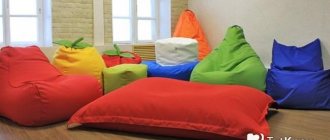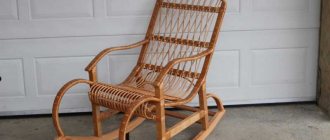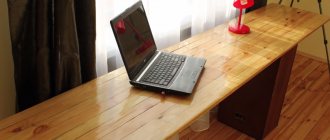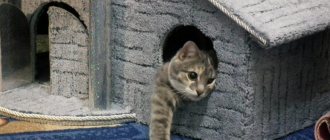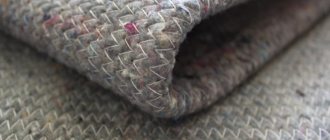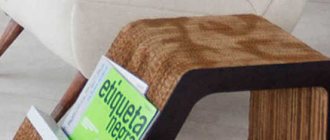Fans of fishing know that enjoying this process will be much more enjoyable if you take special equipment with you to the pond. The feeder chair serves exactly this purpose - creating a more comfortable environment. There are many options for such chairs in stores, many of them are quite expensive. To save your family budget, you can make a feeder chair with your own hands that fully meets the fisherman’s requirements. This is not difficult to do, you just need to prepare the necessary tools and carefully measure all the parts.
What to look for when choosing a fishing chair?
The main indicators that you need to pay attention to first:
- Strength. How much weight can it bear?
- Weight. Fishermen often have to get to their fishing spot on foot, and they always want to get rid of extra pounds of carrying weight.
- Sustainability. There are no perfectly flat surfaces when fishing, so the chair must maintain a vertical position in all situations and not fall along with the fisherman during any movement.
- Compactness. An important factor when transporting and carrying.
- Stay on the surface. Some structures, for example, with tubular legs, are pressed under the weight of the fisherman into a soft surface, such as sand, black soil, etc. For such cases, legs with a larger area of contact with the ground are more suitable.
Convenience and comfort
All chair models offer their own level of comfort for which they are designed. This should be taken into account when choosing, since if you plan to go on long fishing trips, when you need to rest and relax, then perhaps you should choose a chair with a back and armrests, or a folding chair. When you can lean back and take a nap for an hour.
You can complement the chair with the necessary attributes that will be very useful during fishing. For example, install a holder for a fishing rod, you no longer have to cut rods from branches, install a fish bag, a table for changing bait, a sun umbrella, and footrests.
In fact, there are a lot of options on how to equip your fishing spot. If you approach this wisely, the process of fishing will be much more enjoyable.
Material
The main materials for making chairs are the following materials:
- Tree.
- Plastic.
- Metal.
Chairs are mostly made from wood independently. One of the most affordable materials that can be easily processed. Such chairs are strong, reliable and durable.
Let's celebrate! In production, they prefer to use tubes made of plastic or metal. Such a design may even be inferior to wood in some respects. It all depends on the quality of the material, its strength and elasticity. If the material bends in your hands, then you should not hope that it will be able to withstand more than 80 kg of live weight.
Dimensions
- Overall dimensions of compact chairs (LxWxH): 320x410x432 mm;
- Overall dimensions of chairs with back (LxWxH): 410x450x735 mm;
- Overall dimensions of the seats (LxWxH): 741x600x380/740 mm.
Additional options
In order to make a fisherman’s vacation more comfortable, various manufacturing companies offer their clients many additional options. How useful they are, of course, is up to the fisherman to decide.
Let's mention only the most popular ones:
- Back.
- Rod holder.
- Shelf or table;
- Bag or container for fish.
They really simplify the fishing process and make it more comfortable.
What is
A chair for feeder fishing can be made in the form of a simple stool. For greater comfort, it is worth building it more complex: with a back, armrests and a body kit. For a chair to be comfortable to use, it must meet the following requirements:
- Compact design - the chair should easily fit into a backpack when going fishing.
- Lightweight, which is important for carrying over long distances.
- Strength, which affects the ability to support the weight of the fisherman.
- Stability on any surface, since the banks of reservoirs are not perfectly smooth. The safety of the fisherman depends on this.
The legs of a chair for winter fishing should not be thin so as not to be pressed into soft ground or snow under the weight of a person. Another advantage of the feeder chair can be the adjustable back and legs, which allows you to change the height of the backrest and, in a sitting position, relieve tension from the back that arises from being in one position for a long time.
Compact design
Lightness
Strength
Stability on any surface
Manufacturing stages
Taking into account your own skills in making products from different materials, as well as personal wishes, you can build your own chairs for feeder fishing of varying complexity.
Simple model
To make the simplest model of a feeder chair, you will need three interlocking metal pipes with a diameter of 20 mm, material for the seat and back, strong threads, 4 bolts and nuts. Necessary tools: electric drill, hacksaw, grinder. Manufacturing technology:
- The short sides of the seat are stitched with two wide strips and secured at the bottom with a limiter made of a thin strip. In this case, the fabric is sewn directly onto 2 metal pipes, which will serve as the legs of the chair. The material on the back is also stitched along the short sides.
- At the junction of the legs, holes are drilled in the middle of the long sides and connected crosswise to the fasteners.
- A pipe is attached to one of the legs, which will serve as a backrest.
With adjustable legs and backrest
A chair with a back is a more complicated version of a feeder chair. Material required to assemble such a chair: steel pipe for the frame with a diameter of 20 mm, fastenings (bolts, nuts), textiles for the seat and back, threads, rubber nozzles for the legs, anti-corrosion compound. The tools used are the same as for the simple model. Assembly algorithm:
- The metal pipe is cut into several parts: for the legs and seat - 8 pieces of 55 cm, for the back - two pieces of 70 cm, one piece - 30 cm.
- On two pipes, which are intended for sitting, two fasteners are installed at a distance of 6 cm from the beginning and end.
- Another fastener is attached to one of these pipes, with which the back will be mounted. The fastener is located at a distance of 9 cm from the beginning of the pipe.
- To complete the manufacture of the chair frame, the prepared corrugated pipes with fasteners are connected by two more pipes. Thus, 4 metal pieces measuring 55 cm were used.
- Pipes measuring 70 cm prepared for the backrest are connected to a pipe 30 cm long using fasteners.
- The remaining four 55 cm pieces, which will serve as legs, are attached to the ends of the frame tubes. They are equipped with rubber nozzles.
- At the last stage of making the chair, textiles are stretched over the seat and back. Holes are made on the short sides of the tarpaulin, and the material is pulled together using an elastic band. The elastic will allow the seat to sag a little under the weight of the angler. The back textile is pulled together along the long sides.
Made from polypropylene pipes
A simple option for making a feeder chair, for which you will need: PVC pipes with a diameter of 25-32 mm, fittings connecting the parts of the chair, durable textiles for the seat, fasteners, threads. Tools for assembly: pipe cutting scissors or a hacksaw, soldering iron. A guide on how to make a fishing chair from polypropylene pipes with your own hands:
- The tube is cut into pieces: 16 parts for the back, legs, and seat, the length of which you can choose yourself.
- We connect the pipe sections with fittings. For convenience, assembly should begin from the back, then the seat and handles are fastened together.
- For the seat and back, take material that is stitched along the short sides with holes for inserting pipes.
- After checking the structure for stability, it is disassembled, the material is stretched onto the appropriate sections of pipes.
- At the final stage of assembly, the parts are soldered or secured with glue.
Read What is a casting rod and how to choose the right model
Folding chair
To assemble a folding chair, you will need a polypropylene pipe with a diameter of 25 mm, fittings, material for the seat, threads, 2 bolts, 2 nuts. Guide on how to make a folding chair:
- The fabric is cut to a size of 18 cm. It is stitched along the short sides so as to create holes into which the pipes will be inserted.
- The pipe is cut into pieces: 4 pieces of 40 cm and 4 pieces of 20 cm.
- Long pipes have holes drilled in the middle for bolting.
- Short 20 cm sections of pipe are inserted into the prepared fabric. Corners are put on the ends.
- 2 rectangles are formed from all pipe sections measuring 20 x 40 cm. They must be connected with fabric.
- The rectangles are connected to each other with bolts and nuts in the drilled places. It is not recommended to tighten the nuts too tightly so that the chair folds effortlessly.
For structural strength, glue or welding can be used in the places where the fittings are attached. This folding fishing chair will serve for a long time thanks to the material from which it is made, it will be easy to carry, and the chair will not take up much space in your backpack.
Additional accessories
The simplest model of fishing chair is a stool. Some fishermen consider armrests unnecessary, as they can restrict movement. Store-bought products often have body kits - additional devices that make fishing easier. It’s convenient when everything you need is at hand and you don’t have to bend down to the ground to get bait or tackle. You can also build such devices with your own hands, adding them to a fishing chair.
Materials required to make the body kit:
- aluminum pipe with a diameter of 25 mm;
- fittings - tees and angles, 4 pieces each;
- pipe fasteners;
- nuts and bolts;
- plastic box or tabletop;
- plastic clips for securing the pipe.
Required tool:
- electric drill;
- soldering iron;
- hacksaw for metal;
- drill.
Manufacturing technology:
- The holes in the fittings are drilled out to 26 mm so that they can be attached to the legs of the chair.
- The nut is fixed in the plastic tee so that the bolt holds the aluminum pipe in the fitting. A hole with a diameter of 8 mm is drilled in the tee, in which the bolt is installed.
- To obtain a clamp for fixing the pipe inside, the nut is heated with a soldering iron and pressed inside the tee.
- To fasten parts of the body kit, which are required occasionally when fishing, additional holes can be drilled in the corner where the bolt and nut are placed. It is recommended to place a washer under the nut to prevent deformation of the metal tubes.
- The mount for hanging a box or attachment table is made in the form of a pipe placed on the side of the chair, running parallel. From the central support in the middle, an additional pipe is led to the side in the shape of the letter “T” with a leg in the ground. The table is attached with clips screwed to the bottom.
To attach the fishing rod, no additional support devices are required. It is enough to attach an outlet to the leg of the feeder chair. In the same way, you can make a folding chair with fastenings for other useful devices, fixed with fittings to the legs of the chair.
QUALITY AND CONSTRUCTION OF A FISHING CHAIR
The most common options for chairs of this type are options with and without backrest.
- A stool without a back is simpler to make and less expensive in terms of material, however, the first option is much more convenient to use. The back of the chair can be made of wood, that is, the product will be of one-piece construction, or the seat and back are made of durable fabric that is stretched over the base frame.
- You can also divide chairs according to the type of legs - they can be straight, crossed or solid. The material for the chair can be metal, plastic or wood. Making metal or plastic chairs will require special tools and skills, so making them yourself can be quite difficult.
- The option with a wooden chair is the simplest, thanks to the wide range of materials, their affordable price and the ease of use of wood.
At first glance, the drawing of this object rather resembles a Rubik's cube, and it is not at all clear how one can build something following it.
However, the finished chair suggests a slightly different thought - everything ingenious is simple.
Remember that the middle bars are placed in the same way as the outer, wide ones.
- A folding chair, as a rule, consists of 2 planes connected by hinges, as well as a device that regulates the angle of the backrest. Basically, the seat and backrest are made in the form of a frame, made of light metal, on which fabric is stretched, according to the principle of the well-known folding bed. By the way, if you try, you can make a fishing chair from an old folding bed at a minimum cost.
- Box chair. The simplest design consists of a cabinet of a certain height (about 40 cm), on top of which a soft seat is mounted. It also serves as the top cover of the cabinet and has the ability to open. Fishing accessories and fish are stored inside the cabinet.
- Chair with back and armrests. It can be made either folding or solid, but a minibus is needed to transport it, since it will not fit in a regular car. The one-piece version is highly reliable, but you have to pay for it with useful space. The most suitable option is a folding chair. To make such a chair you will have to work hard. For the manufacture of such a structure, lightweight materials should also be used, but with acceptable strength.
- Chair-lounger. The most complex design, the manufacture of which will require a lot of personal time and money. In this case, you will also have to give preference to the folding option. In any case, this is the most suitable option. Its operating principle is similar to a folding chair. It can also be made from 2 folding parts. The only difference is that the parts are made, for example, from plywood and upholstered with soft material. Therefore, this design may take up more space, but it is somewhat more reliable.
- Folding chair - consists of a seat and backrest connected by a hinge.
- Armchair with backrest. Models of this design are either solid or folding. A folding fishing chair is more mobile and can easily fit in a backpack, while a solid product is considered more durable.
- Lounge chair. Chairs of this design, in turn, are divided into prefabricated, solid, and folding.
- Armchair with shelves. The main feature of the model is special devices for placing gear and other fishing accessories on it.
The easiest option to make with your own hands is a folding bed; it can be made from any materials with the least amount of money and time; a lounge chair is a more complex design.
Folding bed With backrest With shelves
This is interesting: Slingshot for fishing - how to make it yourself, popular brand models
Recommendations
Many fishermen practice making various accessories with their own hands. Firstly, it is interesting, and secondly, this approach allows you to save significant money. If you buy a chair for a fisherman, even the simplest one, you will have to part with a certain amount of money, and a considerable one.
But if you have extra funds, and do not have the desire or skills to make at least a basic product with your own hands, then you can go to a fishing store and buy any chair you like. As a rule, the store always has a wide range of similar products that can satisfy any category of consumer. Here you can buy both a simple folding chair and an armchair with armrests: if only you had the money.
Igor 03/11/2018
Description of work stages
It is important to pay attention to the safety of high chairs: Avoid sharp corners, cracks, cracks, cracks, cracks, cracks, gaps between structural elements, as well as unevenness and other defects. To give the top beam an attractive appearance, it can be rounded. The carved rod is designed with all possible patterns in every way, but no sharp corners
The carved rod is designed with all possible patterns in every way, but no sharp corners
To give the top beam an attractive appearance, it can be rounded. The carved rod is designed with all possible patterns in every way, but without any sharp corners.
In this case, the parts are secured with wooden skewers and glue, but other methods such as nails, furniture scales or self-tapping screws can be used.
Read Fishing with foam and details of gear preparation
For additional fastening of bolts, you can use through pins (diameter 6-35 mm).
Chair assembly:
Step 2: Attach the front legs, remaining cross members and stems to the structure.
Step 3: Attach the top, cut and middle crossbars to the back legs (attached at the same height as the seat).
Step 4: Use a special tool, a connecting screw, to make sure that all parts are glued together as securely as possible. It is designed in such a way that the parts are located close to each other.
Step 5: Once all the bottom slats and legs are securely attached, attach the two-panel seat to the base of the chair. For added security and durability, secure the panels with pre-drilled pins after the glue has dried. If the seat boards partially protrude from the floor, the protruding ends should be removed with a chisel.
Video
Any fishing enthusiast will agree that, no matter how exciting fishing is, staying in one position for a long time causes discomfort. Of course, you can simply sit on the grass or snags, but in this position your legs will quickly become numb and your back will begin to ache. To have everything you need at hand and at the same time relax, you can make a feeder chair with your own hands. It's not as difficult as it might seem. The main advantage is that you can save money.
To make such a seat for feeder fishing, you will need materials that are probably available in any garage or shed. You may have to buy a few things, but the costs will not be as high as if you wanted to buy a folding chair in a store.
DIY feeder chair. Part 1
Having seen it one day at a neighbor's place on the ice, an ice fishing enthusiast becomes eager to have his own comfortable feeder chair. But the cost of even the simplest seats for winter fishing in ruble terms is now so substantial (from 7,000 rubles without body kit!) that if a person does not have a significant amount of free money, it is impossible to justify the purchase by any catches or desire for convenience.
Tools in your hands!
It is quite possible to get a comfortable and reliable seat for feeder fishing without breaking another hole in the family budget - you can make it yourself at home. To perform this work, no special skills of a locksmith or a master of sewing on a sewing machine are required.
Everything can be done by a person with average abilities to design and make something; all he needs to do is be determined and stubborn.
After the design of the fishing chair has been thought out, the necessary sketches and outlines have been made, it is necessary to calculate the amount of materials.
If the dimensions of the product are approximately one and a half meters in height and half a meter in width, then you will need materials that can partly be bought in a store, and partly found at home.
It is difficult to choose a more suitable material for the frame of a future chair than a profile pipe. The main advantages of this material:
- cheapness;
- high strength;
- weldability;
- ease of machining.
Necessary materials
Materials from which most homemade feeder chairs of simple designs are made:
- pieces of plywood 8 mm thick;
- steel pipes with a diameter of 20-25 mm with walls whose thickness is not less than 1.5 mm, cutting elements from these pipes for one chair will be: 55 cm - 4 pieces, 70 cm - 2 pieces, 30 cm - 1 piece;
- pieces of fabric with foam padding for covering the seat and back: 800x400 mm – 1 piece; 700x400 mm – 1 piece;
- bolts with nuts and wings of various lengths for assembling legs, seat and back;
- furniture bolts for connecting the seat to the back;
- steel plate for thrust bearings 3 mm thick;
- staples for a construction stapler 6 mm;
- primer and dye for processing the chair frame - in the minimum volume available on the sales counter.
For the feeder, the size of the seat-chair of the universal version is almost the same - 1.5x0.5 m. The given quantities and sizes of elements are based on a simple version without side armrests and an additional shelf for the legs.
If the craftsman considers these elements of the chair to be useful, then he will additionally need the materials of the listed nomenclature, but in a different quantity. Drawings of do-it-yourself corrugated pipe seats can be found in abundance on fishing equipment websites.
Foldable design
One of the most successful designs is a feeder chair with insulated foam upholstery. To stick foam rubber onto plywood, you will need titanium glue, and it is more convenient to prime and paint the finished frame using spray cans. It is better to choose a matte black paint color.
An important detail is that the chair for winter fishing must be foldable, since it will constantly have to be transported, carried, moved every time you go fishing.
It is permissible to make all frame elements from a round aluminum pipe of sufficient strength, in which case the chair will be much lighter. But welding aluminum at home is problematic.
Popular search queries for video clips on the Internet are: “Do-it-yourself feeder chair”, “Make your own feeder chair”, “Chair for a winter feeder”.
Finishing
To increase the durability of the feeder chair and maintain its presentable appearance, different coating options are used. They depend on the material used and can be as follows:
- Wood - treated with an antiseptic composition that actively counteracts mold and mildew. A primer and paint or varnish are also applied on top. This set of procedures will help increase the moisture resistance of the tree, as well as its resistance to temperature fluctuations.
- Metal - the main problem is rust, which destroys the structure of the pipes and the overall strength of the product. Therefore, anti-corrosion treatment is the main task; painting is also allowed.
- Plywood (chipboard) - you need to deal with this material in the same way as with wood; antiseptic treatment, priming and painting are carried out.
Popular Ikea chair-beds - design and design features
In order for a folding chair made by yourself to retain its appearance for as long as possible and remain reliable, you need to provide it with maximum care. After finishing fishing, the product should be cleaned of adhering dirt and dust, and wiped off any possible moisture. It must be stored in a dry place.
It is quite easy to make a feeder chair with your own hands. Although this task requires serious preparation and the availability of tools. When choosing the optimal fishing chair, it is best to choose a combination of a steel frame and textile fabric. It will be durable and resistant to negative external factors.
Treat wooden elements with an antiseptic and, if desired, paint them
Apply a special coating to metal parts to protect against rust.
After fishing, always clean the chair from adhering dirt and grass.
Plastic fishing stool
Since wood is extremely afraid of water, some prefer to use another material - almost weightless plastic, which, moreover, does not tolerate any moisture. To build a lightweight structure you need to prepare:
- pieces of plastic pipes - 4 x 350 mm, the same number of 500 mm;
- plastic corners;
- thick fabric;
- fastening: bolts with nuts.
Long elements are connected in pairs in the middle crosswise using bolts. They are not tightened tightly, otherwise the structure will be difficult to fold. Corners are attached to the ends of the tubes, into which short elements are then inserted.
After receiving the frame, a piece of suitable size is cut out of the material for the seat. It is sewn on a machine, the seat is put on the upper elements, dismantling one of the sides. To secure the legs, a narrow strip of the same fabric is sewn at the bottom. Those who wish can also provide it with a backrest, making it in the same way. It is rigidly mounted to the top of the stool - to the frame of the front legs. The chair is made from metal pipes in the same way.
The simplest option
How to make such a fishing seat with your own hands? If you're happy with a simple design, here's how to make one:
- Decide on the sizes that are right for you.
- Make the corresponding drawings.
- Take two closed rectangular metal pipes.
- Connect them crosswise with a bolt and nut.
- Sew a seat from a wide double strip of tarpaulin on top.
- Make a limiter at the bottom from a thin double strip of fabric.
- Attach another one to one of the arcs, which will act as a backrest.
This is the easiest option for making a folding bed. Although it is important to take into account that its back when unfolded will be in one position.
And here, for example, is a hybrid of a platform and a broken car seat:
Primary requirements
Interesting fishing spots are often located in very inaccessible regions and remote from civilization. This imposes certain additional requirements on all equipment. And city fishing, in the absence of a personal vehicle, forces you to be more careful in choosing gear and additional equipment.
Read Offset hook: how to attach bait
Typically, homemade fishing chairs, chairs and platforms require:
- Sufficient strength. Tourist and fishing furniture must have a sufficient margin of safety in order to withstand the weight of the owner and additional body kit. And it should also be taken into account that the load increases significantly at the time of casting.
- Sustainability. Fishing places are rarely convenient for the arrangement of chairs or armchairs. And when fishing and recasting, the unstable structure can simply fall back or to one side. Sand, clay soil, viscous silt, stones and other options require stability, as well as, ideally, adjustable length of the legs, which will allow you to set your place exactly, regardless of the terrain.
- As compact as possible in transport position. The space in the trunk of a car is not unlimited, and if you do not have your own vehicle and you have to use public transport to get to the fishing point, then this parameter becomes even more important.
- As little mass as possible. This parameter does not fit well with the requirements for the greatest possible strength, since the only way out is to use lighter materials, which sometimes comes at the expense of strength characteristics.
- Availability of materials. If you need to buy only a few parts in a hardware or other store to make a chair or armchair, that’s one thing, but it’s a completely different matter if you need to buy all the materials and tools for the job. In the latter case, a more rational solution would be to buy a ready-made chair in a fishing store.
- Ease of manufacture. If the design requires any special, advanced skills in working with wood or metals, then this is not the most suitable option. Ideally, such furniture should be made in a few hours.
Important! The sizes of chairs or armchairs must be selected taking into account the volume of possible clothing. Few people limit themselves only to summer fishing, and fishing in the fall or spring often requires more than one layer of warm clothing
Tourist and fishing furniture must take into account the possibility of accommodating such additional volume.
Industrial options for feeder fishing chairs
Important accessories for feeder fishing should be at hand: a bucket with bags of dry and home-prepared bait, a box with bait. Not all fishermen are willing to lay out their catch right on the ice at their feet.
Some people, having removed the fish from the hook, immediately put it in a small plastic container or bag. To do this, the container must also be placed near the seat itself, so that the necessary manipulations with the catch can be performed without getting up.
A seat with a folding attachment table and a body kit necessary for winter fishing makes any handling of fish, hook and bait convenient, minimizes time and effort for all auxiliary procedures, making it possible to concentrate only on the main thing - fishing. Even if something suddenly appears in the fisherman’s field of vision, he will not ignore it, while continuing to fish.
A more reliable option for storing individual accessories is in special pockets made in the seat upholstery. This is guaranteed to prevent a sudden gust of wind from blowing away the bait or bait.
In addition, putting all the necessary accessories into the seat pockets and removing all the necessary accessories from there is much more convenient than constantly bending low when everything is laid out on the ice. You can choose any other design of niches and pockets for accessories in the chair, taking into account your individual priorities.
Master class on sewing a chair cover
Sewing a chair bag looks complicated. With some research and a little patience and work, even a beginner can handle this task.
The success of the event is determined by the configuration of the department and the complexity of the reference model. It's best to start with a simple chair and inexpensive fabric.
Let's look at the step-by-step process of sewing upholstery on a chair with a rectangular back and seat with your own hands.
We take measurements
For sewing, the chair cover must be measured by the rectangular back and seat:
- Distance from the top of the seat back to the floor;
- Back height;
- Seat depth;
- The width of the chair (in our example, the width of the back and seats are the same);
- Leg height.
We are building a drawing
It is recommended that you create a schematic drawing before committing to a full-size attachment.
Our model has only three parts: a long rectangle covering the back, seat and floor distance at the front and back, and two rectangles with side panels from the floor to the seat.
The width of the main rectangle corresponds to the width of the chair, adding 2 cm on each side.
The length of the rectangle is determined by the height of the backrest from the floor, from the top of the chair to the seat, the depth of the seat and the height of the feet. It is worth increasing by 1.5 cm on each side.
Transferring the pattern to fabric
Since the chair model we are looking at does not involve a complex pattern, we can go through the step of constructing the design on the paper and assembling the paper pattern on the chair. You can cut out the binding parts directly on the fabric using these diagrams.
The fabric can be applied with chalk, soap or a simple pencil. The ruler is convenient to use, since all sides of the cut are straight.
Sewing a cover
As soon as the details of the future sleeve are cut out, we can start sewing. Sequence of operations:
- Remove the side seams of the seat back;
- Bend and sew the side and bottom slits of the seat back;
- Sew the sides of the cover to the seat;
- Pivot and stitch the side and bottom cutouts of the side and front panels of the lid;
- Machine for internal seams and overlock cuts (Overlock is a special sewing machine for overlock cuts).
Tip: If you don't have a serger, you can sew zigzag stitches or stitches by hand. The stitched lid is unscrewed and the seams are ironed.
Our hand-stitched suitcase is ready!
Material
To make your own feeder chair, the following materials are used:
Chipboard or wood . The peculiarity of such models is that their assembly does not require a welding machine or carving tools.- Steel . To work with this material you will need a special tool and a special protective coating. The advantages of the finished product include: durability, strength and reliability.
- Textiles . When choosing it, you should take into account moisture resistance, strength, wear resistance, and ease of care.
Attention: it is not recommended to use aluminum or plastic in the manufacture of a fishing chair. These materials are not able to withstand heavy loads and are susceptible to deformation during operation.
As you can see, the best option is to use wood. Because it is natural, safe and durable.
Simple chair made of plastic pipes
You can also make a folding chair for fishing with your own hands from what is left, for example, after replacing old water pipes with plastic ones. Such pipes are distinguished by good strength and low weight, which allows you to take the chair without any problems, including to places where you need to travel for a long time on foot. The manufacturing sequence is approximately as follows:
- First of all, you should cut the pipes. To make such a chair you will need 8 parts: 4 pieces 50 centimeters long, and 4 pieces 35 centimeters long.
- From dense fabric (tarpaulin is excellent for such purposes), it is necessary to cut out 2 parts, one of them will actually be the seat (the length must be chosen so that the piece can be folded in half), the other will be used as a jumper that improves the stability of the structure.
- Pipe sections 50 centimeters long are connected in pairs with bolts in the middle crosswise. Using corners, short pieces are attached to long pieces, after which the chair frame is ready.
- A large piece of tarpaulin is used to cover the top of the structure, and a smaller piece is used to connect the legs of the chair in order to prevent their excessive opening.
- The tension of the bolts should be adjusted so that the finished product folds and unfolds without much effort.
A finished fishing chair made from plastic pipes is light and relatively compact; the main drawback is the lack of a backrest, which will make a long fishing session not very comfortable.
How to make a drawing
The first step in creating a fishing chair with your own hands is to complete the drawing. There is a diagram of any chair on the Internet. As a rule, these are drawings of simple structures. More advanced models with additional devices can be drawn with your own hands. Another way to make a drawing is with computer programs.
When choosing the dimensions of a feeder chair - seat width, height of legs and backrest - you should take into account the build of the fisherman who will use it. This will help make your fishing stay more comfortable. For a fisherman of average build, the optimal parameters are considered to be 1.5 x 0.5 m.
If, when making a fishing chair with your own hands, the drawings do not match the width and height parameters, you can safely change them to those that will be optimal.
Fishing stool
Fishing chair with backrest
Arrangement of the feeder's workplace
If you have the right equipment, the only thing left for an ice fisherman to do is set up his workplace well. All elements of equipment used for fishing should be located literally at arm's length from a seated person. This will save him from having to get up often, exposing himself to the cold wind and being distracted from the process of fishing.
The main element of the arrangement is the feeder chair. After all, winter fishing is mainly a passive activity - a person has to sit in one position for a long time. At the same time, the load on the back increases, especially on its lumbar region.
